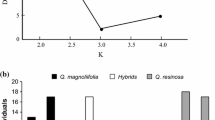Summary
We examined patterns of density and species diversity for leaf-mining Lepidopterans and gall-forming Hymenopterans in two oak (Quercus spp.) hybrid zones: Quercus depressipes x Q. rugosa and Q. emoryi x Q. coccolobifolia. In both species complexes, hybrid hosts typically supported significantly lower densities and species diversity of parasites than did parental types. This contradicts the findings of Whitham (1989) that suggested that hybrid hosts may act as parasite sinks both in ecological and evolutionary time. We discuss features of hybrid zones that are likely to influence patterns of herbivory.
Similar content being viewed by others
References
Bannerjee B (1981) An analysis of the effect of latitude, age, and area on the arthropod pest species of tea. J Appl Ecol 18:339–342
Barton HH, Hewitt GM (1985) Analysis of hybrid zones. Ann Rev Ecol Syst 16:113–148
Brown DE (1982) Madrean Evergreen Woodland. Desert Plants 4:59–65
Bultman TL, Faeth SH (1986) Selective oviposition by a leaf miner in response to temporal variation in abscission. Oecologia 69:117–120
Cottam WP, Tucker JM, Santamour FS Jr (1982) Oak hybridization at the University of Utah. State Arboretum of Utah, Pub No 1. Univ Utah, Salt Lake City, p 82
Craig TP, Price PW, Itami JK (1986) Resource regulation by a stem-galling sawfly on the arroyo willow. Ecology 67:419–425
Darroch JN, Mosimann JE (1985) Canonical and principal components of shape. Biometrika 72:241–252
Drake DW (1981) Reproductive success of two Eucalyptus hybrid populations. II Comparison of predispersal seed parameters. Aust J Bot 29:37–48
Dupont F, Crivelli AJ (1988) Do parasites confer a disadvantage to hybrids? Oecologia 75:587–592
Faeth SH, Connor ED, Simberloff D (1981) Early leaf abscission: a neglected source of mortality for folivores. Am Nat 117:409–415
Feeny P (1976) Plant apparency and chemical defense. In: Wallace JW, Mansell RL (eds) Biochemical interaction between plants and insects. Plenum, New York, pp 1–40
Fernandes GW, Whitham TG (1989) Selective fruit abscission by Juniperus monosperma as an induced defense against predators. Am Midl Nat 121:389–393
Franzen R (1988) Flavonoid diversification of the Achillea ageratifolia and A. clavennae groups (Asteraceae). Am J Bot 75:1640–1654
Harrison RG (1986) Pattern and process in a narrow hybrid zone. Heredity 56:337–349
Heaney LR, Timm RM (1985) Morphology, genetics, and ecology of pocket gophers (genus Geomys) in a narrow hybrid zone. Biol J Linn Soc 25:301–317
Howard DJ (1986) A zone of overlap and hybridization between two ground cricket species. Evolution 40:34–43
Hewitt GM (1988) Hybrid zones — natural laboratories for evolutionary studies. TREE 3:158–167
Kearsley MJC, Whitham TG (1989) Developmental changes in resistance to herbivory: implications for individuals and populations. Ecology 70:422–434
Keim P, Paige KN, Whitham TG, Lark KG (1989) Genetic analysis of an interspecific swarm of Populus: occurrence of unidirectional introgression. Genetics 123:557–565
Key KHL (1968) The concept of stasipatric speciation. Syst Zool 17:14–22
Le Sueur H (1945) The ecology of the vegetation of Chihuahua, Mexico, north of parallel twenty-eight. Univ. Texas Pub. # 4521, p 92
Levy M, Levin DA (1975) The novel flavonoid chemistry and phylogenetic origin of Phlox floridana. Evolution 29:487–499
Little EL Jr (1950) Southwestern Trees. US Dept Agric Handbook No 9. US Government Printing Office, Washington, DC, p 109
Martin JL (1966) The insect ecology of red pine plantations in Central Ontario. IV. The crown fauna. Can Ent 98:10–27
McVaugh R (1974) Flora Novo-Galiciana, The Fagaceae. Contr Univ Michigan Herbarium 12:1–93
Moore WS (1977) An evaluation of narrow hybrid zones in vertebrates. Q Rev Biol 52:263–277
Mosimann JE, James FC (1979) New statistical methods for allometry with application to Florida red-winged blackbirds. Evolution 33:444–459
Paige KN, Keim P, Whitham TG, Lark KG (1989) The use of restriction length polymorphisms to study the ecology and evolutionary biology of aphid-plant interactions. In: Eikenbary RD, Campbell RK (eds) Mechanisms of aphid—plant genotype interactions Elsevier, Amsterdam
Perry TO (1976) Maternal effects on the early performance of tree progenies. In: Cannell MGR, Last FT (eds) Tree physiology and yield improvement. Academic Press, New York, pp 473–481
Potts BM (1986) Population dynamics and regeneration of a hybrid zone between Eucalyptus resdonii Hook f and E. amygdalina Labill. Aust J Bot 34:305–329
Pritchard IM, James R (1984) Leaf fall as a source of leaf miner mortality. Oecologia 64:140–141
Rhoades DF, Cates RG (1976) Toward a general theory of plant anti-herbivore chemistry. In: Wallace JW, Mansell RL (eds) Biochemical interaction between plants and insects. Plenum, New York, pp 168–213
Sage RD, Heyneman D, Lim Kee-Chong, Wilson AC (1986) Wormy mice in a hybrid zone. Nature 324:60–63
Stiling PD, Simberloff D, Anderson LC (1987) Non-random distribution patterns of leaf miners on oak trees. Oecologia 73:116–119
Trelease W (1924) The American Oaks. Mem National Acad Sci 20:1–255 +420 plates (reprinted 1969 by Cramer; Stechert-Hafner Service Agency, NY)
Tucker JM (1959) A review of hybridization in North American oaks. Proc 9th Int Bot Congr II:404–405
Washburn JO, Cornell HV (1981) Parasitoids, patches, and phenology: their possible role in the local extinction of a cynipid gall wasp population. Ecology 62:1597–1607
Whitham TG (1989) Plant hybrid zones as sinks for pests. Science 244:1490–1493
Williams AG, Whitham TG (1986) Premature leaf abscission: an induced plant defense against gall aphids. Ecology 67:1619–1627
Zagory D, Libby W (1985) Maturation-related resistance of Pinus radiata (D Don) to western gall rust. Phytopathology 75:1443–1447
Author information
Authors and Affiliations
Rights and permissions
About this article
Cite this article
Boecklen, W.J., Spellenberg, R. Structure of herbivore communities in two oak (Quercus spp.) hybrid zones. Oecologia 85, 92–100 (1990). https://doi.org/10.1007/BF00317348
Received:
Accepted:
Issue Date:
DOI: https://doi.org/10.1007/BF00317348




